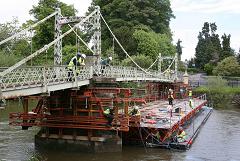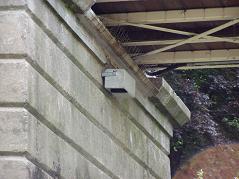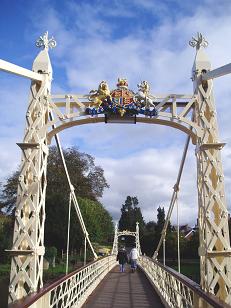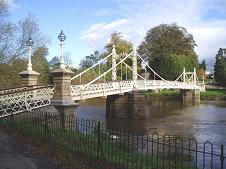Victoria Footbridge Major Maintenance and Repair |

75.8% |
Whole Project Award
Project Team:
Client: Herefordshire Council
Designer: Owen
Williams, Part of Amey plc
Contractor:
Interserve Project Services Ltd
Site character
The Victoria Footbridge in Hereford is a Grade II Listed structure and was built in 1898 to commemorate the Diamond Jubilee of Queen Victoria the previous year. The three-span suspension bridge carries a public footway / cycleway over the River Wye close to Hereford city centre.
The bridge was temporarily closed in 2002 after a hole appeared in the bridge deck, and further emergency repairs were carried out in 2004. Detailed inspection carried out without mechanical plant, on foot and using rope access, revealed significant corrosion to structural elements necessitating works beyond routine maintenance to ensure public safety.
The works included:
- Restoration and repair of structural elements affected by corrosion
- Strengthening structural elements
- Replacement of the bridge deck
- Restoration and refurbishment of the handrails, decorative features, approach pilasters and concrete detailing at the top of the piers and abutments
- Replacement and restoration of lighting.
 |
|
Project Management approach
CEEQUAL was heavily promoted from the outset of the project to ensure a best-practice approach was adopted by the whole project team, in addition to complying with Environmental Management System (accredited to ISO14001) requirements. A project environmental manager was appointed during the design phase, which meant environmental assessments and surveys were undertaken early on, thus ensuring that they influenced the planning and design process and that mitigation measures formed an integral part of the design rather than being an add-on.
Biodiversity
The River Wye is designated as both a Site of Special Scientific Interest (SSSI) and Special Area of Conservation (SAC). Ecological surveys identified that bats were foraging around the bridge, white-clawed crayfish were present in the river and that the site was also important for migratory and spawning fish. To minimise potential adverse impacts, a range of mitigation measures were incorporated including:
- Pursuing working methods that avoided impacts on white-clawed crayfish, breeding fish, and nesting birds
- Programming works to avoid sensitive times of year
- Retaining all existing vegetation. Trees immediately adjacent to the bridge were pollarded as part of advance works avoiding the bird nesting season.
- Full encapsulation of the bridge to prevent any debris entering the river
- Lighting trials were undertaken at night with Natural England present to make certain that the lighting design avoided light spillage onto the river, potentially disturbing foraging bats, migrating fish or other aquatic life.
- During construction, safety navigation lights were shielded to minimise disturbance to aquatic habitat.
In addition to mitigation measures, a number of bird boxes were provided to contribute to biodiversity enhancement.
 |
|
Archaeology & Cultural heritage
Due to the presence of important archaeological sites close to the bridge, the project team planned the site compound location, access routes and working methodology to avoid ground disturbance. This included using a temporary floating pontoon to transport and install a working platform instead of heavy plant.
The Grade II Listing of the structure reflected its architectural and historic importance. It lies within a Conservation Area and an Area of Archaeological Importance and as such, the refurbishment works required the adoption of a sympathetic approach to the restoration of the Victorian features and careful choice of materials. This was achieved through regular consultation with the council’s conservation officer. The existing paint on the bridge was investigated revealing many layers. From this it was possible to determine and specify the original paint colour for the repainting of the steelwork.
 |
|
Resource use
During the design phase options were considered on sustainability and future maintenance grounds. Detailed surveys were undertaken to ensure as much of the structure as possible was preserved and re-used. The deck was replaced with a new durable timber deck (similar to the original bridge design) from an accredited UK sustainable source. New components incorporated can be individually handled and replaced in the future if required, removing the requirement for heavy lifting equipment and expensive access. The bridge steelwork was grit-blasted using recycled grit-blast material to remove the 13 coats of paint and rust. The lighting design for the project incorporated low energy bulbs, which were linked into a green energy supply.
 |
|
Noise and vibration
Different forms of grit-blasting and blast material were considered as well as plant used to reduce any vibration impacts. A space frame below the bridge deck and spanning between the bridge supports was used to support the encapsulation and to eliminate intermediate supports in the river. This, along with no plant on the bridge, eliminated any vibration and disturbance of the river bed.
Community liaison
Keeping the community informed on project progress was considered important throughout. Members of the project team attended local Area Forums, visited schools, met with stakeholders, issued regular press releases and participated in local radio interviews.
Following successful completion of the works, the whole project team organised and participated in the Civic Trust’s Heritage Open Day event (a national event forming part of the European Heritage Initiative).
 |
|
